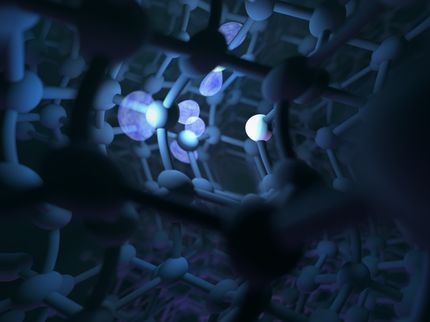NIST physicists show 'molecules' made of light may be possible
It's not lightsaber time, not yet. But a team including theoretical physicists from the National Institute of Standards and Technology (NIST) has taken another step toward building objects out of photons, and the findings hint that weightless particles of light can be joined into a sort of "molecule" with its own peculiar force.
The findings build on previous research that several team members contributed to before joining NIST. In 2013, collaborators from Harvard, Caltech and MIT found a way to bind two photons together so that one would sit right atop the other, superimposed as they travel. Their experimental demonstration was considered a breakthrough, because no one had ever constructed anything by combining individual photons.
Now the NIST and University of Maryland-based team has showed theoretically that by tweaking a few parameters of the binding process, photons could travel side by side, a specific distance from each other. The arrangement is akin to the way that two hydrogen atoms sit next to each other in a hydrogen molecule.
"It's not a molecule per se, but you can imagine it as having a similar kind of structure," says NIST's Alexey Gorshkov. "We're learning how to build complex states of light that, in turn, can be built into more complex objects. This is the first time anyone has shown how to bind two photons a finite distance apart."
"Lots of modern technologies are based on light, from communication technology to high-definition imaging," Gorshkov says. "Many of them would be greatly improved if we could engineer interactions between photons."
For example, engineers need a way to precisely calibrate light sensors, and Gorshkov says the findings could make it far easier to create a "standard candle" that shines a precise number of photons at a detector. Perhaps more significant to industry, binding and entangling photons could allow computers to use photons as information processors, a job that electronic switches in your computer do today.
Not only would this provide a new basis for creating computer technology, but it also could result in substantial energy savings. Phone messages and other data that currently travel as light beams through fiber optic cables has to be converted into electrons for processing - an inefficient step that wastes a great deal of electricity. If both the transport and the processing of the data could be done with photons directly, it could reduce these energy losses.
"It's a cool new way to study photons," he says. "They're massless and fly at the speed of light. Slowing them down and binding them may show us other things we didn't know about them before."
Original publication
M.F. Maghrebi, M.J. Gullans, P. Bienias, S. Choi, I. Martin, O. Firstenberg, M.D. Lukin, H.P. Büchler and A. V. Gorshkov; "Coulomb Bound States of Strongly Interacting Photons"; Phys. Rev. Letters; 2015
Most read news
Original publication
M.F. Maghrebi, M.J. Gullans, P. Bienias, S. Choi, I. Martin, O. Firstenberg, M.D. Lukin, H.P. Büchler and A. V. Gorshkov; "Coulomb Bound States of Strongly Interacting Photons"; Phys. Rev. Letters; 2015
Organizations
Other news from the department science

Get the chemical industry in your inbox
From now on, don't miss a thing: Our newsletter for the chemical industry, analytics, lab technology and process engineering brings you up to date every Tuesday and Thursday. The latest industry news, product highlights and innovations - compact and easy to understand in your inbox. Researched by us so you don't have to.



























































